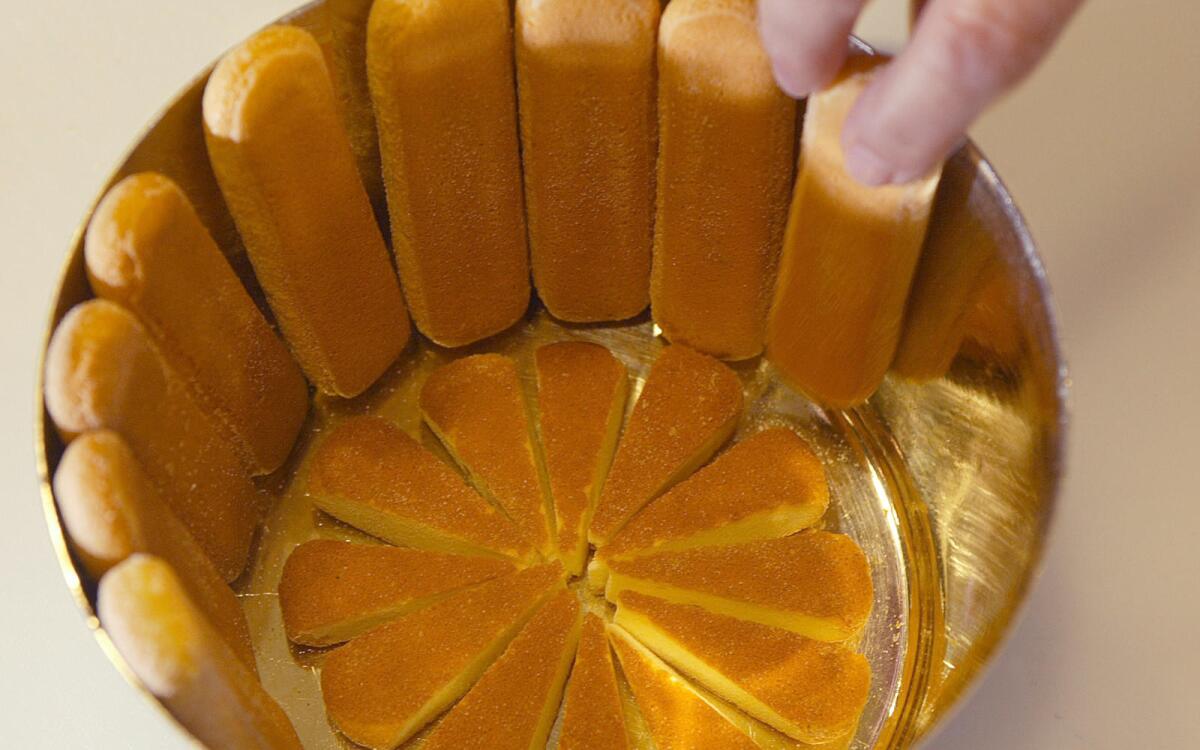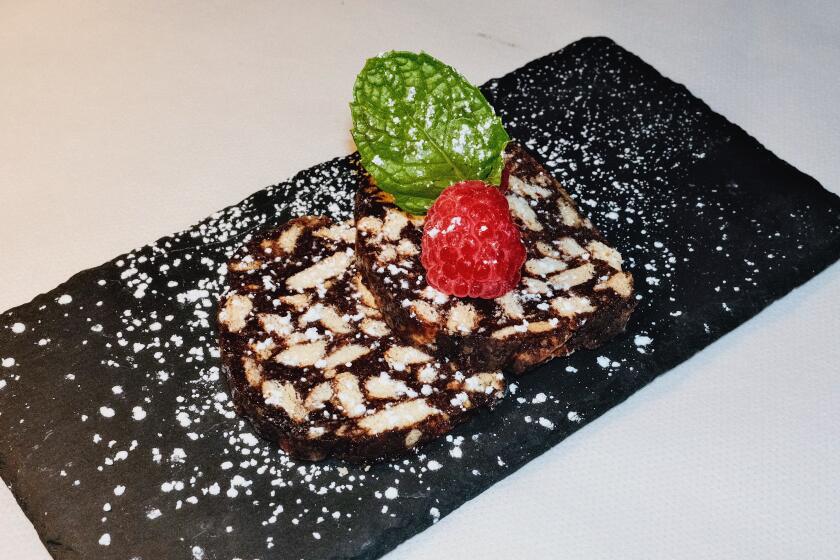Charlotte misu

- Share via
What ever became of charlotte russe? Once upon a time, she was the queen of desserts. It’s time to bring back that golden age, when ladyfingers were ladyfingers and desserts did not shrink from simple grandeur.
A century and a half ago, charlotte russe swept the world and taught it to crave vanilla, spelling an end to centuries of flavoring desserts with rosewater. She remains one of the grandest vehicles for vanilla’s alluring flavor. And in case you hadn’t noticed, vanilla has become a luxury ingredient again.
But she didn’t rise by charm alone. A charlotte russe is an impressive thing, a stately ziggurat of a dessert, upholstered with ladyfingers and filled with a pudding as light as a cloud. The classic version is flavored with vanilla and served with fruit, but let’s reconceive it for a new century. Let’s update it with sophisticated partners such as espresso, bitter chocolate, liqueurs and all the riches of our farmers markets: mulberries, blood oranges, Fuyu persimmons, pluots. Any fruit you like is welcome in a charlotte.
Here’s the thing: You don’t have to be a trained patissier to make a charlotte russe. Queen charlotte is actually quite forgiving. (Keep this quiet.) You can buy the ladyfingers. The only part that involves real cooking is the filling, Bavarian cream -- another dessert that’s in unjustified eclipse.
The lush Bavarian cream is the part that amazes people. So why not simply serve the Bavarian? Why turn it into a charlotte? Two reasons. The ladyfingers edging the Bavarian make it neater and far easier to unmold, and it’s just grander that way. Today, as in the 19th century, charlotte russe is gloriously statuesque, reaching the loftiest heights a Bavarian can without compromising its plush, delicate texture.
What makes a charlotte a charlotte is that it’s shaped in a distinctive flowerpot mold. The earliest versions, which date from about 200 years ago, were actually baked in this mold. They were nowhere near as glamorous as charlotte russe, though. In place of a luxurious cream filling, their centers were stewed fruit, usually apples. Instead of ladyfingers, stale cake or bread was often used for lining the mold.
It’s assumed that apple charlotte was named after Queen Charlotte, the wife of George III of England. The royal family took a keen interest in agriculture; the king was known as “Farmer George” and Charlotte was a patron of apple growers.
French evolution
Charlotte russe was developed from the fruit charlotte by Antonin Careme, the father of French haute cuisine. He originally called it charlotte a la parisienne; the “a la russe” part is assumed to have been tacked on around 1818 to honor the visiting czar of Russia, and possibly with the idea that the white Bavarian cream represented Russia, which the French imagined to be perpetually covered with snow.
What was a French chef doing adapting an English dessert? Apart from the fact that Careme had recently worked for the future George IV of England, French chefs had no qualms in those days about cooking English desserts such as “le pouding” and “le plomb-gateau” (plum cake). They just liked to make them fancier.
As it happens, Careme had also invented Bavarian cream (named for an aristocratic patron, not for Bavaria). His version was essentially a more substantial version of whipped cream, enriched with custard and stiffened with gelatin. Later in the 19th century, chefs would incorporate beaten egg whites as well, giving it a supernal lightness.
In Careme’s time, vanilla was still a very rare and expensive ingredient, gathered wild in Mexico. But in 1841, a freed slave named Edmond Albius invented a technique for pollinating vanilla which made it possible to mass-produce it.
Vanilla started appearing in ice cream and custard -- and above all in charlotte russe. Charlotte quickly became de rigueur in Europe and America. In “Directions for Cookery” (1851), Philadelphia-based Eliza Leslie remarked that charlotte russe was generally served at large parties, “and it is usual to have two or four of them.”
At the end of the 1870s, the classic recipe with added egg whites showed up, and after that, there was not only a deluge of recipes but the dish also began appearing on restaurant menus. In the 1890s, even ruffians at lowlife dives (the better sort of lowlife dive, anyway) were said to order what they called “charley ross.”
The charlotte russe craze continued well into the 1920s, when people were inventing wacky date-nut versions and “angel charlotte russe,” flavored with macaroons, almonds, cherries and marshmallows.
In the 1950s and 1960s, there were shortcut versions using pudding mix enriched with whipped cream as the filling and wholesome “oat squares” in place of ladyfingers. It was a sign that people no longer thought charlotte russe was something grand enough to work at.
Illusion of difficulty
In fact, it’s really quite an easy recipe. The only challenge is making the custard sauce (creme anglaise), which means heating milk, sugar and eggs to the point that the mixture starts to thicken -- you’ll notice that if you stop stirring, it doesn’t keep swirling merrily around in the saucepan but slows to a halt. The classic sign that it’s done is that the mixture will coat the back of a wooden spoon and not just drip off. This happens well before the boiling point; the custard must not get above 180 degrees or it will curdle.
Then you remove it from the heat, add softened gelatin and chill it in the refrigerator, stirring occasionally, or you can speed up the process by stirring it over ice.
After that, all you have to do is whip, fold and wait; whip, fold and wait. Beat egg whites (without a speck of egg yolk in them, of course, or they won’t beat high) until they form stiff peaks. Fold them carefully into the custard so that the air bubbles become evenly dispersed throughout. This is done by repeatedly scooping the custard up through the whites from the bottom of the bowl, rather than stirring around and around in the usual way.
If the gelatin hardens too fast, don’t despair. Set the bowl in a larger bowl of hot water and stir until it softens. Then chill until it starts to stiffen again. Once the egg whites are incorporated, chill the mixture until it starts to set. Whip cream and fold it in, and your work is over, except for scooping the Bavarian cream into the charlotte mold.
The traditional charlotte russe still is a grand thing, a terrific way to showcase vanilla once again, along with the berries of spring and early summer. To perk up packaged ladyfingers, we brush them with rum after unmolding, and serve each slice with a swirl of rich red strawberry coulis. (Other spirits or liqueurs, as well as fruit syrups, would also revivify packaged ladyfingers nicely.)
When you go shopping for ladyfingers, you find yourself in an Italian deli, because ladyfingers are mostly used for tiramisu these days. That gave us an idea: a tiramisu-style charlotte russe. Flavor the Bavarian with amaretto liqueur and layer it with grated bitter chocolate. Drench the ladyfingers just before serving with espresso and finish this plush dessert with a sweet, creamy sauce of espresso and coffee.
Call it charlotte misu. Or in ruffian-talk, maybe, Charley Meese.
The mold they didn’t break
You can mold a charlotte in a 2-quart souffle mold, but the ideal utensil is the charlotte mold. It has sloping sides for easy unmolding, and it’s 4 inches high -- ladyfinger height. It’s usable for other purposes such as custards and aspics.
The traditional charlotte mold is made of tinned steel, which has to be thoroughly dried after washing and preferably wiped with an oiled cloth as well. With heavy use, it will eventually have to be re-tinned.
Espresso sauce
Combine all of the ingredients in a small saucepan. Bring to a boil, turn down and simmer for a few minutes until the mixture thickens. Serve warm or at room temperature. May be covered and refrigerated until ready to serve. Makes about 1 cup.
Charlotte and assembly
Cut 6 ladyfingers in half then make a V shape on one end of each to form a teardrop shape. Arrange the teardrops in the bottom of a 2-quart charlotte mold with the V pointing in to the middle, forming a flower design. Line the sides of the mold with 16 ladyfingers with the sugar side facing out.
Whip the cream with one-fourth cup sugar until stiff. Beat in the vanilla and set aside.
Place the milk in a small saucepan over medium heat and bring to a simmer. Meanwhile, beat the egg yolks and three-fourths cup sugar on medium-high speed until pale yellow, scraping down the sides of bowl as needed, for about 1 1/2 minutes.
Place the egg mixture in a medium saucepan and stir in a little of the hot milk to blend, then stir in remaining milk. Cook, stirring constantly, until the mixture thickens, about 2 1/2 minutes, being careful not to let it lump. Remove from the heat before the mixture starts to boil.
In a small bowl, sprinkle the gelatin over one-fourth cup cold water to soften. Strain the custard through a very fine strainer into a glass bowl and stir in the softened gelatin, stirring until the gelatin has dissolved. Set the bowl in a larger bowl filled with ice and water and continue to stir until it cools and just begins to set. Stir in the amaretto.
Remove the bowl from the ice water. Beat the egg whites to stiff peaks and gently fold into the custard. Fold in the whipped cream.
Spoon one-fourth of the mixture into the bottom of the mold. Sprinkle 2 tablespoons of finely chopped chocolate over the top. Add another one-fourth of the custard and sprinkle with more chocolate making four layers of custard and chocolate, ending with chocolate. Chill until set, at least 6 hours or overnight.
To serve, place a plate over the top of the mold and holding it down with the handles, turn the mold over and lift it away. Brush the ladyfingers with the espresso or coffee, repeating several times to saturate the cookies. Sprinkle chocolate curls and remaining chopped chocolate on top. Slice and serve with espresso sauce.
Get our Cooking newsletter
Get a taste of Los Angeles — and the world — with recipes and kitchen tricks from the L.A. Times’ Cooking newsletter.
You may occasionally receive promotional content from the Los Angeles Times.















